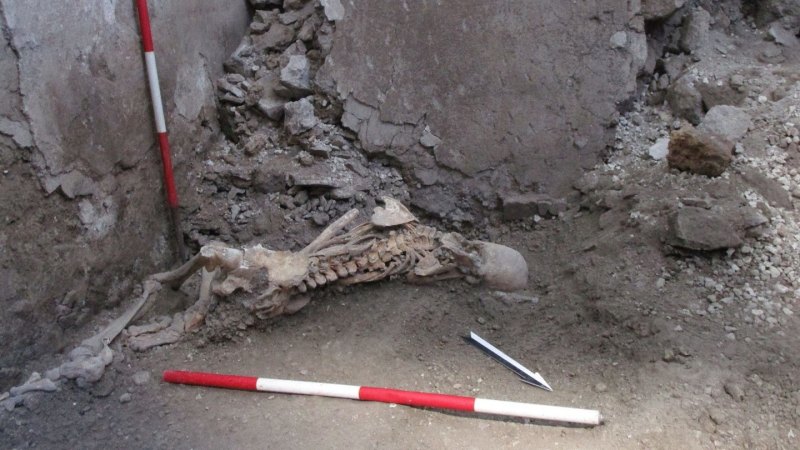
In A.D. 79, a massive volcano in southern Italy suddenly, explosively awoke, leading to one of the ancient world’s deadliest natural disasters. Ash and gas from the eruption killed at least 1,500 people in the ancient cities of Pompeii and Herculaneum. Now, a new analysis suggests that powerful earthquakes concurrent with the eruption may have been yet another killer, volcanologist Domenico Sparice of the Istituto Nazionale di Geofisica e Vulcanologia in Naples and colleagues report July 17 in Frontiers in Earth Science.
Previous excavations of Pompeii have revealed residents fully encased in ash, their preserved bodies telling a powerful tale of a swift, scalding end. In Herculaneum, people that sought shelter in stone boathouses may have survived the heat only to slowly suffocate from volcanic gases (SN: 1/23/20).
In the new analyses, Sparice and colleagues studied collapsed buildings in Pompeii, as well as the skeletons of two people found within one such building. The individuals’ observed injuries are similar to injuries caused by collapsing buildings during modern earthquakes, the team reports.
Mount Vesuvius’s eruption nearly 2,000 years ago ejected thick clouds of superhot gases, ash and rock into the stratosphere — a suffocating, scalding mix that swiftly fell back to Earth and blanketed nearby Roman cities. Adding to the destruction, the volcano also sent pyroclastic flows, dense currents of hot gas and rock, speeding down its slopes toward the cities closest to its feet.
An eyewitness to the event, Pliny the Younger, described the eruption in a series of letters from his vantage point in Misenum, across the Bay of Naples from the volcano. In one letter, he wrote of “earth tremors” felt at Misenum that became “so violent that everything felt as if it were being shaken and turned over.”
Such strong, seismic shocks caused by the force of the eruption, Sparice says, may have forced Pompeii’s inhabitants to make a deadly choice: Seek shelter from the eruption inside buildings made unstable by powerful quakes or flee outside into the scalding ash.
To learn more about what role the quakes may have played in the death toll, Sparice and colleagues turned to two newly excavated rooms in a house found in an area of Pompeii known as the Insula of the Chaste Lovers. The walls were decorated with unfinished frescoes, while piles of mortar were found leaning against garden walls and resting on the kitchen counter. Vesuvius had apparently interrupted the building’s renovations.
The two individuals found in the house were both male and around 50 years old when they died. Their skeletons were lying near large blocks of masonry — remnants of a crumbled partition wall. Multiple rib fractures, as well as severe fractures to pelvic, arm, and facial bones, suggest that the men experienced powerful crushing forces. One man was huddled on his left side, his left hand protecting his head, as if he had been trying to take cover.
Taken together, that evidence suggests the men took shelter from and survived the initial hot rain of gas and ash, which lasted about 18 hours. Some ash did penetrate the house, probably through cracks in doors and windows. But the chunks of wall rests on top of that ash, rather than below it. Sparice’s team hypothesizes that after the ashfall dwindled, the ground shook powerfully — earthquakes strong enough to destroy the house’s partition walls and crush the men.
Those killer quakes may have been the result of the collapse of the volcano’s central crater, or caldera, the team says, which heralded the onset of the volcano’s final, deadliest phase. Pyroclastic currents of hot gas, ash and molten rock then swept across the region, burying Pompeii beneath a 1.8-meter-thick layer of sediment.
The findings confirm “what archaeologists have assumed was the reality,” in part due to Pliny the Younger’s account, says archaeologist Kevin Dicus of the University of Oregon in Eugene. “I appreciate the evidence-based approach — it takes us from assuming that earthquake tremors were just as destructive at Pompeii to providing a methodology to measure this theory.”
The analysis also “gives us a better picture of what the people at Pompeii went through on that day, and why some people chose to stay and ride it out,” Dicus says. “It was clearly already a hellscape outside. The ash cloud turned day to night, rock and ash were raining on them. Now we can add a violently trembling ground to the mix.”
Such studies also help revise the picture of who was trapped by the eruption, Dicus adds. Scientists had once thought that it was mostly the old, the infirm or the enslaved who could not escape the destruction. “We are starting to realize that a true cross section of the population is represented in the bones and body casts.”
#Earthquakes #added #Pompeiis #death #toll
Image Source : www.sciencenews.org



